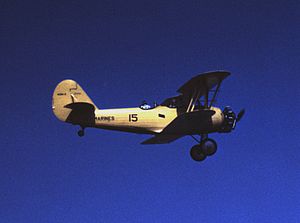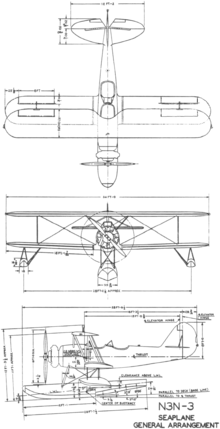avia.wikisort.org - Aeroplane
The Naval Aircraft Factory N3N was an American tandem-seat, open cockpit, primary training biplane aircraft built by the Naval Aircraft Factory (NAF) in Philadelphia, Pennsylvania, during the 1930s and early 1940s.
| N3N | |
|---|---|
 | |
| US Marine Corps N3N-3 over Parris Island, 1942 | |
| Role | Training aircraft |
| National origin | United States |
| Manufacturer | Naval Aircraft Factory |
| First flight | August 1935[1] |
| Introduction | 1936 |
| Retired | 1961 |
| Primary user | United States Navy |
| Produced | 1935-1942 |
| Number built | 997 |
Development and design
Built to replace the Consolidated NY-2 and NY-3, the N3N was successfully tested as both a conventional airplane and a seaplane.[1] The seaplane used a single float under the fuselage and floats under the outer tips of the lower wing. The conventional airplane used a fixed landing gear. The prototype XN3N-1 was powered by a Wright J-5 radial engine. An order for 179 production aircraft was received.[1] Near the end of the first production run the engine was replaced with the Wright R-760-2 Whirlwind radial. The aircraft is constructed using Alcoa's extruded aluminum, with bolts and rivets, rather than the more common welded steel tubing fuselages. Early production models used aluminum stringers formed for cancelled airship construction orders.[2][3][4][5]
Operational history

The N.A.F. built 997 N3N aircraft beginning in 1935. They included 179 N3N-1s and 816 N3N-3s, plus their prototypes. Production ended in 1942, but the type remained in use through the rest of World War II. The N3N was the last biplane in US military service - the last (used by the U.S. Naval Academy for aviation familiarization) were retired in 1959. The N3N was also unique in that it was an aircraft designed and manufactured by an aviation firm wholly owned and operated by the U.S. government (the Navy, in this case) as opposed to private industry. For this purpose, the U.S. Navy bought the rights and the tooling for the Wright R-760 series engine and produced their own engines. These Navy-built engines were installed on Navy-built airframes.[3]
According to Trimble, "The N3N-3, sometimes known as the Yellow Bird for its distinctive, high-visibility paint scheme, or less kindly, Yellow Peril for the jeopardy in which student aviators often found themselves, showed itself to be rugged, reliable, and generally forgiving to student pilots."[3]
Four N3N-3s were delivered to the United States Coast Guard in 1941. Postwar, many surviving aircraft were sold on the US civil aircraft market and bought for operation by agricultural aerial spraying firms and private pilot owners. A number are still (as of 2014) active in the USA.
Variants

- XN3N-1
- First prototype aircraft, Bureau of Aeronautics number 9991.
- N3N-1
- Two-seat primary trainer biplane, powered by a 220-hp (164-kW) Wright J-5 radial piston engine. 179 were built.
- XN3N-2
- One prototype only (Bureau number 0265) powered by a 240-hp (179-kW) Wright R-760-96 radial piston engine.
- XN3N-3
- One production N3N-1 (0020) converted into a 'dash three' prototype.
- N3N-3
- Two-seat primary trainer biplane, powered by a 235-hp (175-kW) Wright R-760-2 Whirlwind 7 radial piston engine. 816 built.[1]
Operators


 United States
United States
- United States Coast Guard
- U.S. Marines
- United States Navy
- Chilean Naval Airforce 4 N3N-1 received by Lend-Lease Program
- Cuban Naval Airforce 5 N3N-1s received by Lend-Lease Program.
Surviving aircraft

- 0719 – On display at the Museo Nacional Aeronáutico y del Espacio in Santiago.[6]
- 1918 – On display at the Warhawk Air Museum in Nampa, Idaho.[7][8]
- 2582 – On display at the Western Antique Aeroplane & Automobile Museum in Hood River, Oregon.[9][10]
- 2621 – On display at the Yanks Air Museum in Chino, California.[11][12]
- 2693 – On display at the National Museum of Naval Aviation in Pensacola, Florida.[13][14]
- 2733 – Airworthy with the High Sierra Squadron of the Commemorative Air Force in Reno, Nevada.[15][16]
- 2782 – On display at the Mid-Atlantic Air Museum in Reading, Pennsylvania.[17][18]
- 2827 – On display at the Yanks Air Museum in Chino, California.[19][20]
- 2831 – On display at the Evergreen Aviation and Space Museum in McMinnville, Oregon.[21][22]
- 2892 – On display at the Military Aviation Museum in Virginia Beach, Virginia.[23][24]
- 2951 – On display at the Kalamazoo Aviation History Museum in Kalamazoo, Michigan.[25][26]
- 2959 – On display at the USS Lexington Museum in Corpus Christi, Texas.[27][28]
- 3022 – On display at the National Air and Space Museum's Udvar Hazy Center in Chantilly, Virginia.[29][30]
- 3046 – On display at the National Museum of Naval Aviation in Pensacola, Florida.[31][32]
- 4406 – Airworthy with Bernie Air Services in Sandown, Isle of Wight.[33][failed verification]
- 4480 – On display at the Yanks Air Museum in Chino, California.[34][35]
- 4497 – On display at the Pima Air & Space Museum in Tucson, Arizona.[36][37]
Specifications (N3N-3)

Data from Holmes, 2005. p. 96.
General characteristics
- Crew: 2
- Length: 25 ft 6 in (7.77 m)
- Wingspan: 34 ft 0 in (10.36 m)
- Height: 10 ft 10 in (3.3 m)
- Wing area: 305 sq ft (28.3 m2)
- Empty weight: 2,090 lb (948 kg)
- Gross weight: 2,792 lb (1,266 kg)
- Powerplant: 1 × Wright R-760-2 Whirlwind radial , 235 hp (175 kW)
Performance
- Maximum speed: 126 mph (203 km/h, 109 kn)
- Range: 470 mi (756 km, 410 nmi)
- Service ceiling: 15,200 ft (4,635 m)
- Rate of climb: 900 ft/min (4.6 m/s)
Communications were done by the instructor through a speaking tube to the student in the front cockpit. Communications back were agreed-upon gestures.[38]
See also
Aircraft of comparable role, configuration, and era
- Avro Cadet
- Avro Tutor
- Boeing-Stearman Kaydet
- Breda Ba.25
- Focke-Wulf Fw 44
- Polikarpov U-2
- Yokosuka K5Y
References
Citations
- Holmes, 2005. p. 98.
- Gene Smith (February 1989). "A Dream of Wings". Air Progress.
- Trimble, William (1990). Wings for the Navy: a history of the Naval Aircraft Factory, 1917-1956. Annapolis: United States Naval Institute. pp. 127–139, 336–337. ISBN 9780870216633.
- "Military Aircraft, Trainers". Evergreen Aviation and Space Museum. Retrieved 25 October 2020.
- Bailey, Stewart (2009). "N3N-3 Yellow Peril Joins the Museum Collection" (PDF). Evergreen Museum. Retrieved 25 October 2020.
- "Airframe Dossier - Naval Aircraft Factory N3N-1, s/n 500 FACh, c/n 0719, c/r CC-DME". Aerial Visuals. Retrieved 28 September 2022.
- ""YELLOW PERIL"". Warhawk Air Museum. Retrieved 13 August 2016.
- "Airframe Dossier - Naval Aircraft Factory N3N-3, s/n 1918 USN, c/r N45305". Aerial Visuals. AerialVisuals.ca. Retrieved 13 August 2016.
- "Naval Aircraft Factory N3N-3". Western Antique Aeroplane and Automobile Museum. WAAAM. Retrieved 13 August 2016.
- "Airframe Dossier - Naval Aircraft Factory N3N-3, c/n 2582, c/r N45042". Aerial Visuals. AerialVisuals.ca. Retrieved 13 August 2016.
- "Naval Aircraft Factory N3N-3". Yanks Air Museum. Yanks Air Museum. Archived from the original on 29 June 2016. Retrieved 13 August 2016.
- "Airframe Dossier - Naval Aircraft Factory N3N-3, c/r N44757". Aerial Visuals. AerialVisuals.ca. Retrieved 13 August 2016.
- "N3N "YELLOW PERIL" (FLOATPLANE)". National Naval Aviation Museum. Naval Aviation Museum Foundation. Retrieved 13 August 2016.
- "Airframe Dossier - Naval Aircraft Factory N3N-3, s/n 2693 USN". Aerial Visuals. AerialVisuals.ca. Retrieved 13 August 2016.
- "N3N High Sierra Squadron". Commemorative Air Force. Retrieved 28 September 2022.
- "FAA Registry [N4009A]". Federal Aviation Administration. U.S. Department of Transportation. Retrieved 28 September 2022.
- Rambow, Bill. "Naval Aircraft Factory N3N-3 "Yellow Peril"". Mid-Atlantic Air Museum. Avialantic. Retrieved 13 August 2016.
- "Airframe Dossier - Naval Aircraft Factory N3N-3, s/n 02782 USN, c/r N44718". Aerial Visuals. AerialVisuals.ca. Retrieved 13 August 2016.
- "Naval Aircraft Factory N3N-3". Yanks Air Museum. Yanks Air Museum. Archived from the original on 29 June 2016. Retrieved 13 August 2016.
- "Airframe Dossier - Naval Aircraft Factory N3N-3, s/n 02827 USN, c/r N45280". Aerial Visuals. AerialVisuals.ca. Retrieved 13 August 2016.
- "Military Aircraft". Evergreen Museum Campus. Evergreen Museum. Retrieved 13 August 2016.
- "Airframe Dossier - Naval Aircraft Factory N3N-3, s/n 02831 USN, c/r N3NN". Aerial Visuals. AerialVisuals.ca. Retrieved 13 August 2016.
- "Navy Hangar". Military Aviation Museum. Military Aviation Museum. Retrieved 13 August 2016.
- "Airframe Dossier - Naval Aircraft Factory N3N-3, s/n 02892 USN, c/r N120BH". Aerial Visuals. AerialVisuals.ca. Retrieved 13 August 2016.
- "Naval Aircraft Factory Yellow Peril". Air Zoo. Air Zoo. Retrieved 13 August 2016.
- "Airframe Dossier - Naval Aircraft Factory N3N-3, s/n 2951 USN, c/r N9308Z". Aerial Visuals. AerialVisuals.ca. Retrieved 13 August 2016.
- "N3N YELLOW PERIL". USS Lexington. USS LEXINGTON Museum On The Bay. Retrieved 13 August 2016.
- "Airframe Dossier - Naval Aircraft Factory N3N-3, s/n 02959 USN, c/r N6358T". Aerial Visuals. AerialVisuals.ca. Retrieved 13 August 2016.
- "Naval Aircraft Factory N3N". Smithsonian National Air and Space Museum. Retrieved 13 August 2016.
- "Airframe Dossier - Naval Aircraft Factory N3N-3, s/n 03022 USN". Aerial Visuals. AerialVisuals.ca. Retrieved 13 August 2016.
- "N3N "YELLOW PERIL" (CONVENTIONAL GEAR)". National Naval Aviation Museum. Naval Aviation Museum Foundation. Retrieved 13 August 2016.
- "Airframe Dossier - Naval Aircraft Factory N3N-3, s/n 3046 USN". Aerial Visuals. AerialVisuals.ca. Retrieved 13 August 2016.
- "Airframe Dossier - Naval Aircraft Factory N3N-3, c/r G-ONAF". Aerial Visuals. Retrieved 28 September 2022.
- "Naval Aircraft Factory N3N-3". Yanks Air Museum. Yanks Air Museum. Archived from the original on 29 June 2016. Retrieved 13 August 2016.
- "Airframe Dossier - Naval Aircraft Factory N3N-3, s/n 04480 USN, c/r N695M". Aerial Visuals. AerialVisuals.ca. Retrieved 13 August 2016.
- "YELLOW PERIL". Pima Air & Space Museum. Pimaair.org. Retrieved 13 August 2016.
- "Airframe Dossier - Naval Aircraft Factory N3N-3, s/n 04497 USN, c/r N45084". Aerial Visuals. AerialVisuals.ca. Retrieved 13 August 2016.
- "National Naval Aviation Museum - Online Exhibits". Archived from the original on 2011-10-02. Retrieved 2011-07-09.
Bibliography
- Ford, Daniel (September–October 1999). "Sought After Classic: N3N-3 Canary — Often Misidentified, Always Loved!". Air Enthusiast (83): 68–71. ISSN 0143-5450.
- Holmes, Tony (2005). Jane's Vintage Aircraft Recognition Guide. London: Harper Collins. ISBN 0-00-719292-4.
- Sapienza, Antonio Luis (May 2001). "L'aviation militare paraguayenne durant la seconde guerre mondiale" [Paraguayan Military Aviation During the Second World War]. Avions: Toute l'Aéronautique et son histoire (in French) (98): 30–33. ISSN 1243-8650.
External links
- "NAVAL AIRCRAFT FACTORY N3N YELLOW PERIL", by Jack McKillop, provides a detailed description of the N3N and its development.
На других языках
[de] Naval Aircraft Factory N3N
Die Naval Aircraft Factory N3N ist ein zweisitziger Doppeldecker, der hauptsächlich als Schulflugzeug bei US Navy eingesetzt wurde. Gebaut wurde die N3N bei der Naval Aircraft Factory in Philadelphia. Sie wurde sowohl als Land- und als Wasserflugzeug gebaut. Die Wasserflugzeug-Variante hatte einen großen Zentralschwimmer sowie zwei kleine Schwimmer an den Flügelenden. Das Landflugzeug hatte ein festes Fahrwerk. Die Flugzeugzelle war eine mit Stoff bespannte Metallkonstruktion.- [en] Naval Aircraft Factory N3N
[fr] NAF N3N Canary
Le NAF N3N Canary était un biplan biplace d'entraînement de base construit par Naval Aircraft Factory (NAF) à Philadelphie (Pennsylvanie). Le N3N a été construit sous deux versions principales : une version terrestre et une version hydravion. L'hydravion utilisait un gros flotteur unique sous le fuselage et de petits flotteurs latéraux sous les ailes inférieures. La version terrestre utilisait un train d'atterrissage fixe. L'appareil était propulsé par un moteur en étoile Wright R-760 Whirlwind (en) développant une puissance de 225 ch (168 kW). Beaucoup de ces moteurs ont également été construits sous licence par NAF.[it] Naval Aircraft Factory N3N
Il Naval Aircraft Factory N3N fu un aereo da addestramento monomotore e biplano sviluppato dalla Naval Aircraft Factory (NAF), impianto produttivo situato al Philadelphia Naval Shipyard ed alle dipendenze della United States Navy, la marina militare degli Stati Uniti d'America, nei primi anni trenta.Другой контент может иметь иную лицензию. Перед использованием материалов сайта WikiSort.org внимательно изучите правила лицензирования конкретных элементов наполнения сайта.
WikiSort.org - проект по пересортировке и дополнению контента Википедии